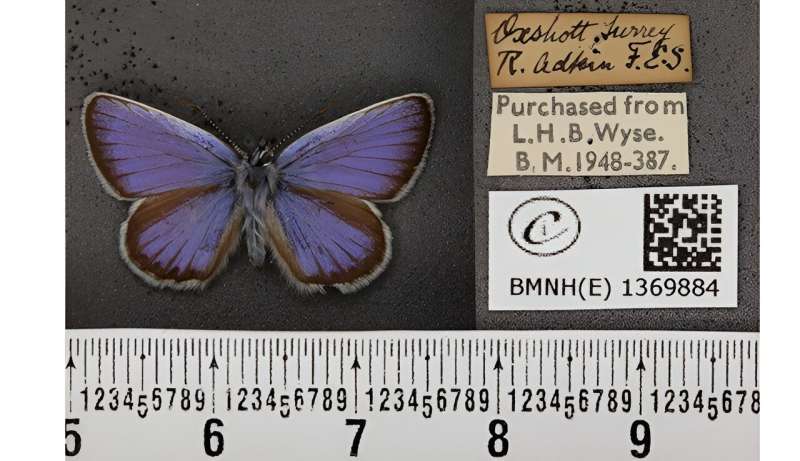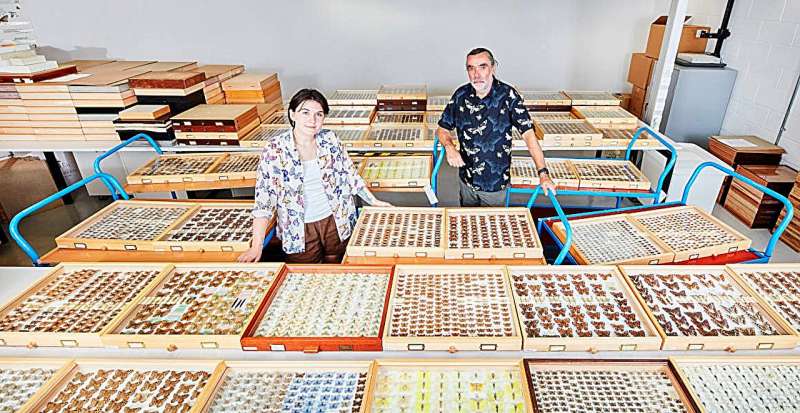This article has been reviewed according to Science X's editorial process and policies. Editors have highlighted the following attributes while ensuring the content's credibility:
fact-checked
trusted source
proofread
Digitizing UK museum collections could help to boost the global economy

Investing in natural history collections could help to supercharge UK science.
More than 130 million objects, collected over hundreds of years, are held in these collections. This makes them a valuable source of information about what the Earth's climate and biodiversity was like when they were collected, showing how our planet has changed over time due to human impacts.
However, just 6% of the UK's natural history collections are currently available on the Global Biodiversity Information Facility (GBIF), a database that provides information about all life on Earth. This limits how useful these collections can be to researchers around the world.
Digitizing specimens means they can be accessed by anyone, anywhere and at any time. It's estimated that UK researchers alone have saved over £1.4 million in time and travel costs by using the digital specimens which are currently available from the country's museums, with the total figure more than 10 times higher.
Dr. Ken Norris, deputy director of science at the Natural History Museum and co-author of the report available on Zenodo, says, "It's estimated that over 50% of the world's GDP, or around $44 trillion, is dependent on the natural world."
"By understanding what is in collections now, both on a national and international scale, we can identify trends, necessary actions, and what we need to collect to underpin policy and investment decisions for a future where people and planet thrive."
Why is digitizing natural history collections important?
Across the UK, it's estimated that these are more than 137 million different items in natural sciences collections. These range from fossils to meteorites, and pressed plants to animals preserved in spirits.
The Natural History Museum holds the majority of these items, housing more than 80 million of the objects spanning the entirety of the 4.56 billion years that life has existed on Earth.
Around a decade ago, the Museum first began the mass digitization of its collections to make them more accessible to researchers. This involves uploading information, and where possible images, about a specimen to the publicly accessible Data Portal.
So far, over 5.6 million specimens have been digitized at the Natural History Museum, which represents about 7% of the entire collection.
For the UK's natural history collections as a whole, the average is around 6%. Even though this data only represents a small proportion of the overall data in museums and other institutions, it's still immensely valuable and is estimated to save researchers at least £18 million.
Many of these savings are from not having to physically visit collections, especially if specimens are spread out around the world. The data uploaded to GBIF currently allows scientists to access information on species from 248 countries and territories, with more than 39 billion records downloaded.
This has contributed to over 2,700 scientific papers tackling some of the biggest issues of our time, including climate change, invasive species and biodiversity loss. Data from specimens held in UK collections punches above its weight, as while just 0.3% of all the records on GBIF are from the country, it is cited in 12% of peer-reviewed papers making use of the database.

Digitizing collections also allows for significant time savings. For instance, researchers working on a recent study looking at how climate change is affecting butterflies didn't have to painstakingly measure the size of thousands of specimens as they were able to make use of a dataset of over 180,000 butterflies from the Natural History Museum. The digitization of butterflies like these is being accelerated by a program known as "Mothra."
Mothra is able to process the same amount of specimens in a week as would take a human 3,000 hours, a length of time equivalent to about four months. In reality, it's likely the system saves a scientist working eight-hour days with no breaks around two years, allowing them to devote this time to other research.
In some cases, this research simply wouldn't be possible without digitized collections. Previous research reveals that almost half of researchers wouldn't be able to conduct their investigations without GBIF data, while another 41% added that while it would be possible, they would have to do much more work.
While scientists are already working hard with the currently available data, it's important that even more is made available. To help speed up this process in the UK, the Natural History Museum is set to build a science and digitization center near Reading where 27 million specimens will be housed.
The UK's natural science collections are also working together in the Distributed System of Scientific Collections (DiSSCo UK) project, which aims to make specimens from across the country freely and easily available online.
DiSSCo UK is making the case that investing £155 million on digitizing the critical mass of natural science collections across the UK would lead to as much as a ten-fold return on the investment. These specimens would then be more readily available for uses such as drug development, crop improvement and conservation.
Eventually, it's hoped that the UK's digitized natural history specimens will one day form part of a global digital collection, formed of the items housed in all of the world's museums. Together, these specimens will provide the data behind the decisions that will shape the future of our planet.
The report's lead author and the deputy head of digital, data and informatics at the Natural History Museum, Helen Hardy, says, "The advancement of digitization has been truly transformational to the scientific community."
"Today we are using software that allows individuals to realize an entire life's amount of information gathering in just a few months! Anticipation is high for further innovations, such as the integration of artificial intelligence into taxonomic work."
More information: Helen Hardy et al, Users and Uses of Natural History Collections—A Summary, Zenodo (2023). DOI: 10.5281/zenodo.8369299
Provided by Natural History Museum
This story is republished courtesy of Natural History Museum. Read the original story here




















